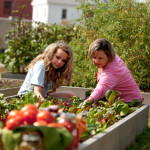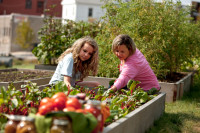Top 7 Tips for Edible Gardening in Calgary
With the warmer weather finally arriving, it is an exciting time for wanna-be and seasoned gardeners alike to be planning their edible garden. With Calgary’s unique growing climate, here are the top 7 tips for edible gardening to help with the success of your crops this year.
Soil is everything to the success of an edible garden! Good garden soil maintains a balance between how quickly water drains through the soil and how much water is retained. Hence, the soil is never too wet or too dry.
For planting, the ground should be moist but not sopping wet. If the soil sticks to your boots or tools it is too wet to dig. Digging soil when it is wet will run the soil’s structure and you will be left with clods of dirt not a rich growing environment. If your soil is very dry and dusty, water it for several hours and let the area sit for a day or two while the water percolates. To test for proper soil moisture, squeeze a ball of soil together in the palm of your hand. It should keep its shape when you open your hand and crumble when touched. Now that you know when the time is right to plant in your soil, here are tips for a successful edible garden.
Top 7 Tips for Edible Gardening in Calgary:
- Choose only plant varieties that will mature in 45 to 80 days. Check the “Days to Maturity” on the seed package. Remember that the days to maturity does not include the time it takes for seeds to germinate and sprout so you have to add on the sprouting time to see if you can grow the
 crop in less than 80 days.
crop in less than 80 days. - Plant only what you want to eat. Consider how much of any one crop you
will eat. - Pick easy to grow food crops that attract few insect pests when you are
starting out. - Decide if you can plant using seeds or seedlings to grow the crop. Look for seed varieties that are described as “heat resistant”, “slow to bolt”, “long standing”, and “resistant to disease”. Seed varieties labeled as “especially suited to containers” are good for small urban gardens. If buying seedlings, avoid seedlings with roots growing out of the bottom of the pot as this means the plant is root bound and will take some special care in order to get established after it is transplanted.
- Decide where to plant the seeds and seedlings. Know how tall and wide
each food crop will be when it is mature so that you give the right amount of space to each variety. Seed packages and seed catalogues will tell you the plant’s dimensions and spacing needed. - Plant cool season food crops such as peas, kohlrabi, lettuce, spinach,
carrots and beets in early spring. Wait until the soil warms up and all danger of frost is over before planting the warm season crops (beans, tomatoes, cucumbers, eggplant, peppers, winter and summer squashes and corn). - Consider if and when during the growing season you will be away from the garden and not harvesting. Plant crops that will be ripening when you are there to care for and harvest them.
Most importantly have fun, try growing something new this year.
adapted from Ready, Set, Plant! Food Gardening in Calgary published in Millrise Spin
by Ruth Anne Rudack



Comments are closed.